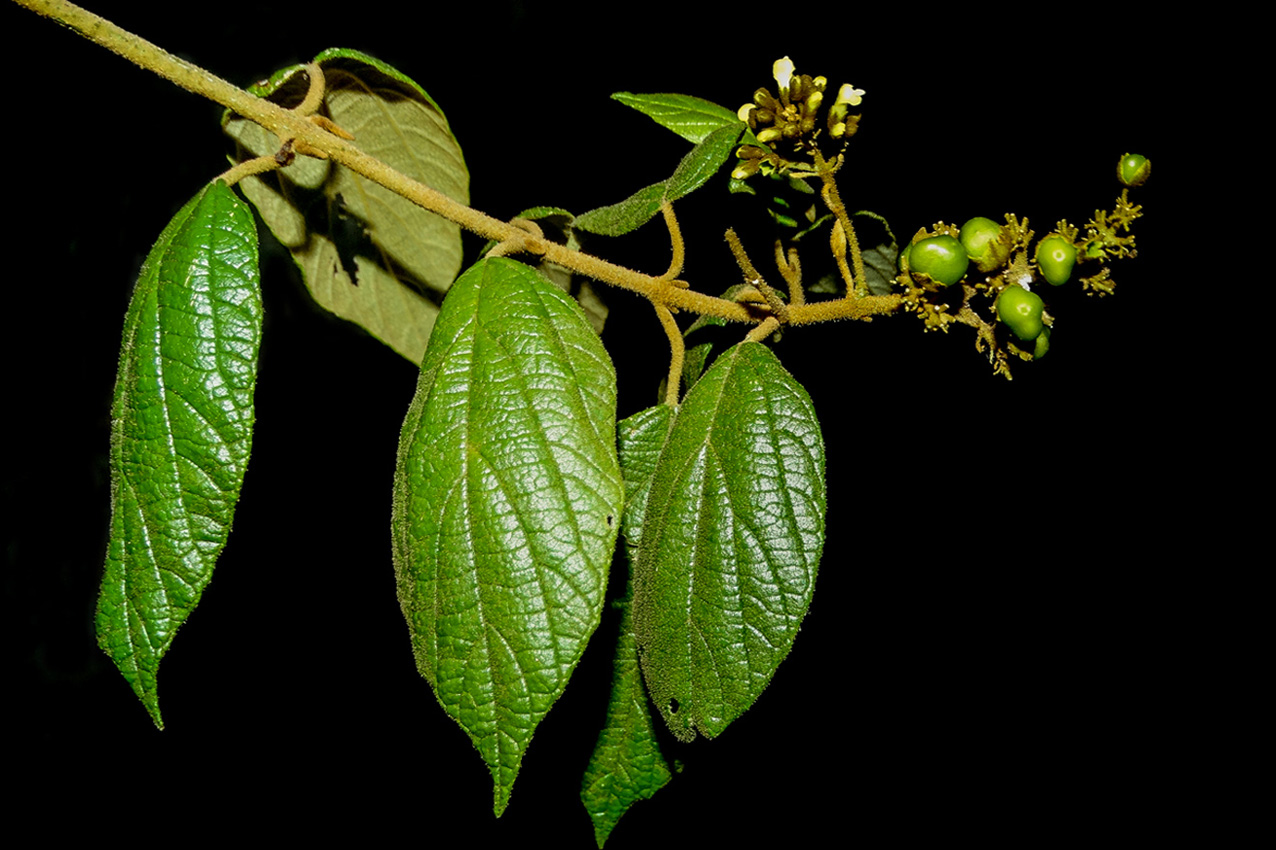Abstract
Premna mwadimei (Lamiaceae), a distinct new species from the coastal forests of Kenya, Cha Simba area in Kilifi County, is described here with photographs. It is closely similar to P. chrysoclada and P. tanganyikensis but mainly differs from both by its habit, nature of the older stems, indumentum, leaf shape and floral morphology.
References
<p>Aublet, J.B.C. (1775) <em>Histoire des Plantes de la Guiane Françoise</em>, Pierre François Didot, London & Paris, 235 pp.</p>
<p>Briquet, J. (1897) Verbenaceae.<em> In: </em>Engler, A. & Prantl, K. (Eds.) <em>Die natürlichen Pflanzenfamilien nebst ihren Gattungen und wichtigeren Arten, insbesondere den Nutzpflanzen, unter Mitwirkung zahlreicher hervorragender Fachgelehrten begründet. Teil.4, Abt. 3a.</em> Engelmann, Leipzig, pp. 132–182.</p>
<p>Beentje, H.J. (1994) <em>Kenya trees, shrubs and lianas</em>. National Museums of Kenya, Nairobi, 722 pp.</p>
<p>Bojer, W. (1835) Descriptiones et Icones plantarumquas in insulis Africa australisdetexit anno 1824. <em>Annales des Sciences Naturelles, Botanique</em> 2 (4): 262–269.</p>
<p>Cantino, P.D. (1992) Evidence for a polyphyletic origin of the Labiatae. <em>Annals of the Missouri Botanical Garden </em>79: 361–379. https://doi.org/10.2307/2399774</p>
<p>Chen, S.L. & Gilbert, M.G. (1994) <em>Premna</em>.<em> In: </em>Wu, C.Y. & Raven, P.H. (Eds.) <em>Flora of China. Vol. 17.</em> Science Press, Beijing & Missouri Botanical Garden Press, St. Louis, pp. 16–27.</p>
<p>Cheek, M. & Dorr, L. (2007) Sterculiaceae.<em> In: </em>Beentje, H.J. & Ghazanfar, S.A. (Eds.) <em>Flora of Tropical East Africa</em>, <em>Sterculiaceae</em>. Royal Botanic Gardens, Kew, pp. 29–32.</p>
<p>Engler, A. (1898) Beitragezur Flora von Affika. XV. <em>Botanische Jahrbücher für Systematik, Pflanzengeschichte und Pflanzengeographie</em> 24: 465–509.</p>
<p>Gürke, R.L.A.M. (1903) Verbenaceae AfricanaeⅢ. <em>Botanische Jahrbücher für Systematik, Pflanzengeschichte und Pflanzengeographie</em> 33: 209–384.</p>
<p>Harley, R.M., Atkins, S., Budantsev, A.L., Cantino, P.D., Conn, B.J. & Grayer, R. (2004) Labiatae.<em> In: </em>Kadereit, J.W. (Ed.) <em>The Families and Genera of Vascular Plants</em>. Berlin, Springer Verlag, pp. 167–275. https://doi.org/10.1007/978-3-642-18617-2_11</p>
<p>Hiern, W.P. (1896) <em>Catalogue of the African Plants</em>. British Museum, London, 179 pp.</p>
<p>Hutchinson, J. (1914) <em>Bulletin of Miscellaneous Information</em>. Royal Gardens, Kew, 335 pp. https://doi.org/10.2307/4119469</p>
<p>IUCN (2020) <em>The IUCN Red List of Threatened Species, version</em> 2020.3. IUCN Red List Unit, Cambridge U.K. Available from: https://www.iucnredlist.org/(accessed 3 March 2021)</p>
<p>Jacquin, N.J. (1763) <em>Selectarum Stirpium Americanarum Historia</em>. Ex Officina Krausiana, Vindobonae, 282 pp.</p>
<p>Leschenault, M. (1810) Mémoire Sur le <em>Strychnostieute </em>et l'<em>Antiaristoxicaria</em>, plantesvénéneuses de Vile de Java. <em>Annales du Muséum National d'Histoire Naturelle</em> 16: 459–483.</p>
<p>Li, B.,Cantino,P.D., Olmstead, R.G., Bramley, G.L.C., Xiang, C.L., Ma, Z.H., Tan, Y.H. & Zhang, D.X. (2016) A large-scale chloroplast phylogeny of the Lamiaceae sheds new light on its subfamilial classification. <em>Scientific Reports</em> 6: 34343. https://doi.org/10.1038/srep34343</p>
<p>Linnaeus, C. (1771) <em>Mantissa Plantarum. </em>Salvius, Stockholm, 587 pp.</p>
<p>Moldenke, H.N. (1959) Notes on new and noteworthy plants. XXIV. <em>Phytologia </em>7: 77–86. https://doi.org/10.5962/bhl.part.5039</p>
<p>Verdcourt, B. (1992) Verbenaceae.<em> In: </em>Polhill, R.M. (Ed.) <em>Flora of Tropical East Africa</em>, <em>Verbenaceae</em>. Royal Botanic Gardens, Kew, <br>pp. 1–157.</p>
<p>Zhao, F., Chen, Y.P., Salmaki, Y., Drew, B.T., Wilson, T.C., Scheen, A.C., Celep, F., Bräuchler, C., Bendiksby, M., Wang, Q. & Min, D.Z. (2021) An updated tribal classification of Lamiaceae based on plastome phylogenomics. <em>BMC Biology</em> 19: 1–27. https://doi.org/10.1186/s12915-020-00931-z</p>
<p>Briquet, J. (1897) Verbenaceae.<em> In: </em>Engler, A. & Prantl, K. (Eds.) <em>Die natürlichen Pflanzenfamilien nebst ihren Gattungen und wichtigeren Arten, insbesondere den Nutzpflanzen, unter Mitwirkung zahlreicher hervorragender Fachgelehrten begründet. Teil.4, Abt. 3a.</em> Engelmann, Leipzig, pp. 132–182.</p>
<p>Beentje, H.J. (1994) <em>Kenya trees, shrubs and lianas</em>. National Museums of Kenya, Nairobi, 722 pp.</p>
<p>Bojer, W. (1835) Descriptiones et Icones plantarumquas in insulis Africa australisdetexit anno 1824. <em>Annales des Sciences Naturelles, Botanique</em> 2 (4): 262–269.</p>
<p>Cantino, P.D. (1992) Evidence for a polyphyletic origin of the Labiatae. <em>Annals of the Missouri Botanical Garden </em>79: 361–379. https://doi.org/10.2307/2399774</p>
<p>Chen, S.L. & Gilbert, M.G. (1994) <em>Premna</em>.<em> In: </em>Wu, C.Y. & Raven, P.H. (Eds.) <em>Flora of China. Vol. 17.</em> Science Press, Beijing & Missouri Botanical Garden Press, St. Louis, pp. 16–27.</p>
<p>Cheek, M. & Dorr, L. (2007) Sterculiaceae.<em> In: </em>Beentje, H.J. & Ghazanfar, S.A. (Eds.) <em>Flora of Tropical East Africa</em>, <em>Sterculiaceae</em>. Royal Botanic Gardens, Kew, pp. 29–32.</p>
<p>Engler, A. (1898) Beitragezur Flora von Affika. XV. <em>Botanische Jahrbücher für Systematik, Pflanzengeschichte und Pflanzengeographie</em> 24: 465–509.</p>
<p>Gürke, R.L.A.M. (1903) Verbenaceae AfricanaeⅢ. <em>Botanische Jahrbücher für Systematik, Pflanzengeschichte und Pflanzengeographie</em> 33: 209–384.</p>
<p>Harley, R.M., Atkins, S., Budantsev, A.L., Cantino, P.D., Conn, B.J. & Grayer, R. (2004) Labiatae.<em> In: </em>Kadereit, J.W. (Ed.) <em>The Families and Genera of Vascular Plants</em>. Berlin, Springer Verlag, pp. 167–275. https://doi.org/10.1007/978-3-642-18617-2_11</p>
<p>Hiern, W.P. (1896) <em>Catalogue of the African Plants</em>. British Museum, London, 179 pp.</p>
<p>Hutchinson, J. (1914) <em>Bulletin of Miscellaneous Information</em>. Royal Gardens, Kew, 335 pp. https://doi.org/10.2307/4119469</p>
<p>IUCN (2020) <em>The IUCN Red List of Threatened Species, version</em> 2020.3. IUCN Red List Unit, Cambridge U.K. Available from: https://www.iucnredlist.org/(accessed 3 March 2021)</p>
<p>Jacquin, N.J. (1763) <em>Selectarum Stirpium Americanarum Historia</em>. Ex Officina Krausiana, Vindobonae, 282 pp.</p>
<p>Leschenault, M. (1810) Mémoire Sur le <em>Strychnostieute </em>et l'<em>Antiaristoxicaria</em>, plantesvénéneuses de Vile de Java. <em>Annales du Muséum National d'Histoire Naturelle</em> 16: 459–483.</p>
<p>Li, B.,Cantino,P.D., Olmstead, R.G., Bramley, G.L.C., Xiang, C.L., Ma, Z.H., Tan, Y.H. & Zhang, D.X. (2016) A large-scale chloroplast phylogeny of the Lamiaceae sheds new light on its subfamilial classification. <em>Scientific Reports</em> 6: 34343. https://doi.org/10.1038/srep34343</p>
<p>Linnaeus, C. (1771) <em>Mantissa Plantarum. </em>Salvius, Stockholm, 587 pp.</p>
<p>Moldenke, H.N. (1959) Notes on new and noteworthy plants. XXIV. <em>Phytologia </em>7: 77–86. https://doi.org/10.5962/bhl.part.5039</p>
<p>Verdcourt, B. (1992) Verbenaceae.<em> In: </em>Polhill, R.M. (Ed.) <em>Flora of Tropical East Africa</em>, <em>Verbenaceae</em>. Royal Botanic Gardens, Kew, <br>pp. 1–157.</p>
<p>Zhao, F., Chen, Y.P., Salmaki, Y., Drew, B.T., Wilson, T.C., Scheen, A.C., Celep, F., Bräuchler, C., Bendiksby, M., Wang, Q. & Min, D.Z. (2021) An updated tribal classification of Lamiaceae based on plastome phylogenomics. <em>BMC Biology</em> 19: 1–27. https://doi.org/10.1186/s12915-020-00931-z</p>


